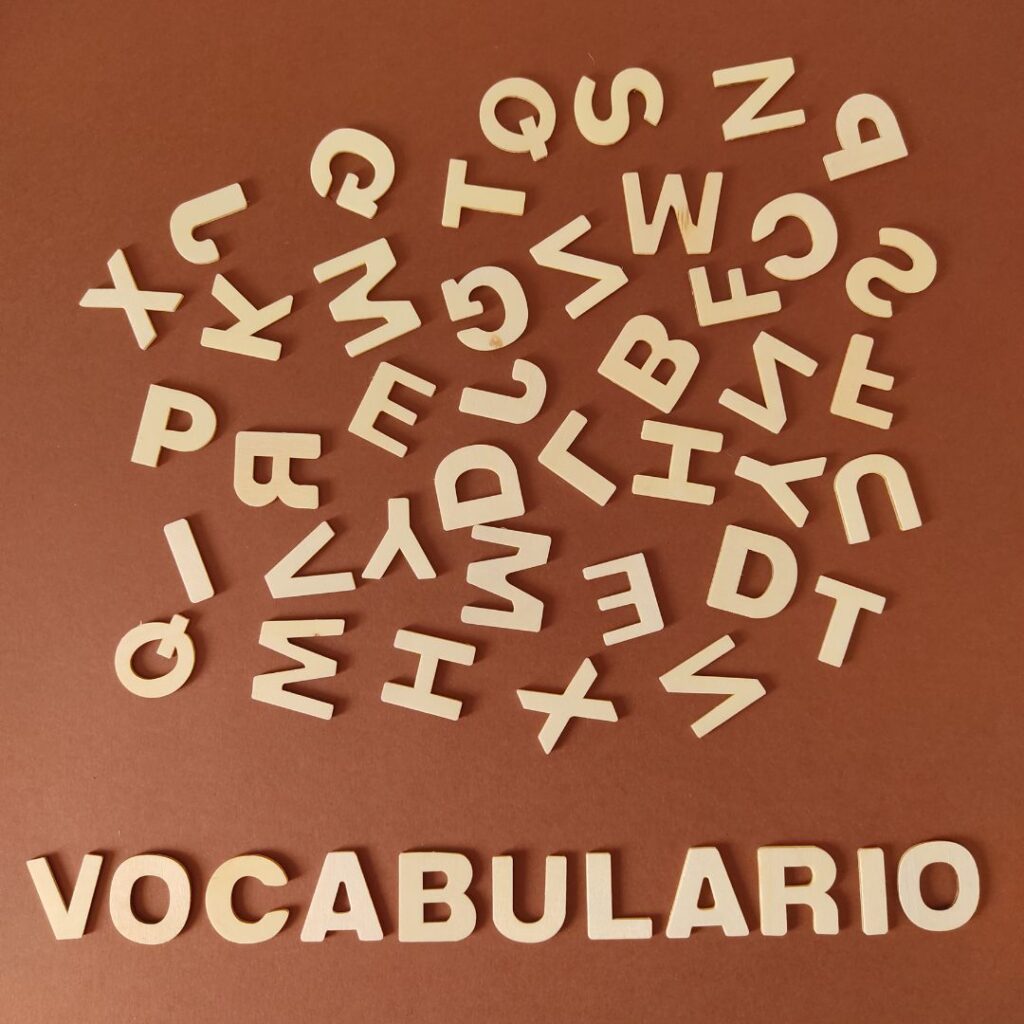ELL students face unique difficulties in acquiring vocabulary due to their limited English proficiency. However, with the right strategies to teach key vocabulary to ELL educators, students can create a supportive learning environment that fosters vocabulary development and language acquisition.
Vocabulary is understanding how to use words in relation to their meaning. Developing new vocabulary involves more than just looking up words in a dictionary and using those words in sentences. 1
Strategies for teaching vocabulary to ELL students:

Several strategies to teach key vocabulary to ELL students can be effective:
1. Add graphics and images:
Graphics and images can serve as a universal language that bridges the gap between languages. Even if ELL students are not yet proficient in English, they can still understand and connect with the visuals, enabling them to participate in vocabulary activities and discussions.
ELL students may have difficulty grasping new vocabulary words through verbal explanations alone, but visual aids can make the meaning clearer and more accessible.
English learners benefit greatly from visual aids when learning new vocabulary. Incorporate pictures, diagrams, and real-life objects to help them understand and remember new words.
Overall, adding graphics and images to vocabulary instruction for ELL students is a powerful strategy that can enhance comprehension, retention, engagement, and language production.
2. Provide specifics.:
Teaching vocabulary strategies for ELL students in meaningful contexts. Use sentences, stories, or real-life situations to help students understand how words are used in different contexts. This will help them grasp the meaning and usage of the words more effectively.
Create a positive and encouraging classroom environment where ELL students feel comfortable taking risks and making mistakes when using new vocabulary.
You can teach prefixes, suffixes, and root words to help students understand the meaning of unfamiliar words. Provide examples and non-examples to clarify the meaning and usage of words. Use sentences or short stories that incorporate the target vocabulary. This helps students make connections and understand how the words are used in context.
3. Use graphic organizers:
Graphic organizers, such as word maps or concept maps, can help ELL students organize and categorize new vocabulary. This visual representation helps them make connections between words and understand their relationships. Using graphic organizers is an effective strategy for teaching vocabulary strategies for ELL students.
Graphic organizers like word maps, concept circles and word walls are visual tools that help students organize and understand information, making it easier for them to grasp new vocabulary words. Here are some specific strategies for incorporating graphic organizers into vocabulary instruction for ELL students:
4. Use repetition and reinforcement:
It is one of the perfect strategies to teach vocabulary to ELL students. ELL students need repeated exposure to new vocabulary to reinforce their learning. Provide multiple opportunities for practice through activities like repeat and review, word games, and quizzes.
Students can play and replay these games, using an increasingly difficult set of vocabulary words each time as they scaffold their learning. Bonus points are awarded when they can use a previous vocabulary word to help describe a current vocabulary word. 2
Create a classroom environment where ELL students feel comfortable using the vocabulary words in their spoken and written communication. By using repetition and reinforcement strategies, teachers can support ELL students in building their vocabulary skills and enhancing their overall language proficiency.
5. Encourage active engagement:
Engage students in hands-on activities that require them to use the new vocabulary. This can include role-playing, discussions, and interactive exercises that promote the active use and understanding of the words. Incorporate elements of competition, teamwork, or creativity to keep students engaged and motivated.
6. Use scaffolding techniques:
Scaffolding is a method that provides support and guidance to students as they learn new concepts and vocabulary. Break down complex vocabulary into smaller, more manageable parts. Teach root words, prefixes, and suffixes to help students decipher the meaning of unfamiliar words. You can Incorporate real-life examples and visuals to help ELL students connect new vocabulary words to their own experiences.
This can include using photographs, videos, or real objects to make the vocabulary more tangible and meaningful. Recognize and celebrate the progress ELL students make in acquiring new vocabulary. This can include praise, certificates, or other forms of positive reinforcement to motivate and encourage their language development.
7. Incorporate technology:
There are various online resources and apps available that can help ELL students practice and reinforce their vocabulary skills. These interactive platforms make learning vocabulary more engaging and fun for students. You can use online dictionaries and translation tools.
Provide ELL students with access to online reading materials, such as news articles or blogs, that are appropriate for their language level. These are excellent strategies for teaching ELL students vocabulary.
8. Foster a language-rich environment:
Create classroom environment strategies that promote language learning. This means creating an environment where students are surrounded by opportunities to hear and use new vocabulary in meaningful contexts. Display word walls, labels, and charts to reinforce vocabulary. Encourage students to use new words in their conversations and written work.
Read aloud to students regularly, using books and texts that contain rich and varied vocabulary. Pause to explain and discuss new words, and encourage students to ask questions or share their own thoughts about the story.
Utilize multimedia resources such as videos, songs, and online interactive activities that highlight vocabulary words. This helps engage students and provides additional visual and auditory support.
9. Provide opportunities for authentic language use:
One strategy for teaching vocabulary to English Language Learner (ELL) students is to provide opportunities for authentic language use. Give ELL students opportunities to use new vocabulary in real-life situations.
Role-play scenarios, group discussions, and presentations allow them to practice and apply the words they have learned. Make connections between the vocabulary being taught and real-world objects, places, or experiences.
Take students on field trips to places where they can use the vocabulary in context, such as a grocery store or a park. Assign projects or tasks that require students to use the new vocabulary in a meaningful and creative way.
For example, have students create a brochure or a poster advertising a product or a place using the vocabulary they have learned.
10. Provide individualized support:
Before starting vocabulary instruction, assess the student’s current knowledge and understanding of vocabulary. This will help you determine their starting point and tailor your instruction accordingly. Recognize that each ELL student has unique needs and learning styles.
If possible, provide bilingual support for ELL students by offering translations or explanations in their native language. This can help them make connections between the new vocabulary and their existing knowledge.
Extra Thoughts about strategies for teaching ELL students vocabulary:

1. Highlighting Vocabulary and Phrases in Context:
One of the best strategies for teaching vocabulary to ELL students is highlighting vocabulary and phrases in context. By providing examples of how words and phrases are used in real-life situations, students can better understand and remember their meanings. This can be done through reading texts, listening to conversations, or watching videos that include the target vocabulary.
Teachers can also encourage students to actively engage with the vocabulary by asking them to identify and discuss the highlighted words and phrases in context. This strategy helps ELL students develop their language skills and enhances their overall comprehension and communication abilities.
2. Practice with graphic organizers:
One of the effective strategies for teaching vocabulary to ELL students is through the use of graphic organizers. Graphic organizers are visual tools that help students organize and understand information.
By using graphic organizers, ELL students can visually see the relationships between words, concepts, and ideas, which can aid in their comprehension and retention of vocabulary. These organizers can include word webs, concept maps, and Venn diagrams, among others.
By engaging in hands-on practice with graphic organizers, ELL students can actively interact with the vocabulary, making connections and deepening their understanding of the words.
This strategy can be particularly beneficial for ELL students who may struggle with language barriers, as it provides them with a visual and interactive way to learn and internalize new vocabulary.
3. Vocabulary colour chips:
Vocabulary colour chips are a useful strategy for teaching vocabulary to English Language Learners (ELL) students. These chips are small cards or pieces of paper that are colour-coded to represent different categories or themes of vocabulary words.
Each colour represents a different category such as animals, food, or emotions. By using these chips, teachers can engage students in interactive and hands-on activities to learn and practice vocabulary.
Students can sort and match the chips based on their colours and categories, helping them to make connections and reinforce their understanding of the words.
This strategy not only makes vocabulary learning more engaging and enjoyable for ELL students but also enhances their retention and comprehension of new words.
4. Guide students on how to use dictionaries:
One effective strategy for teaching vocabulary to English language learners (ELL) is to guide them on how to use dictionaries. Dictionaries are powerful tools that can help ELL students expand their vocabulary and improve their language skills.
Teachers can teach students how to effectively use dictionaries by explaining the different parts of a dictionary entry, such as the word’s meaning, pronunciation, and usage.
Additionally, teachers can provide practice activities where students look up words in a dictionary and use them in sentences or conversations. By teaching ELL students how to use dictionaries, teachers empower them to become independent learners and develop their language skills.
5. Put new vocabulary on a word wall, and review the words daily.
Swap out old words as necessary. Using a word wall is a highly effective strategy for teaching vocabulary to English Language Learners (ELL) students. By putting new vocabulary on a word wall, students can visually see and interact with the words daily. This helps them to remember and understand the meaning of the words more easily.
Additionally, having the words displayed in a prominent place in the classroom allows for frequent exposure and reinforcement of the vocabulary. Students can refer to the word wall when reading or writing, and it can serve as a valuable resource for independent learning. Overall, incorporating a word wall into vocabulary instruction for ELL students is a practical and impactful strategy.
6. Previewing Unfamiliar Vocabulary:
Previewing unfamiliar vocabulary is an essential strategy for teaching vocabulary to English Language Learners (ELL) students. By previewing unfamiliar vocabulary, teachers can introduce new words to students before encountering them in a text or lesson.
This allows students to become familiar with the words and their meanings, making it easier for them to comprehend and engage with the material.
Previewing unfamiliar vocabulary also helps students build their vocabulary bank and develop their language skills. Teachers can use various techniques such as pre-teaching vocabulary, providing visual aids, and using context clues to help ELL students understand and remember new words.
Overall, previewing unfamiliar vocabulary is a valuable strategy that supports ELL students in their language learning journey.
FAQ about strategies to teach vocabulary to ELL students:
1. What is the best way to teach vocabulary to ESL students?
The best way to teach vocabulary to ESL students is through a combination of various techniques. This includes using visual aids such as flashcards or pictures to associate words with their meanings, incorporating hands-on activities and games to make learning engaging and interactive, providing ample opportunities for practice and repetition, and encouraging students to use the new vocabulary in context through speaking and writing exercises.
Additionally, incorporating real-life examples and situations relevant to the student’s interests and backgrounds can help make the learning process more meaningful and effective.
2. What are the 3 vocabulary teaching strategies? – What are the 3 strategies for teaching vocabulary to ELL students?
Three strategies to teach key vocabulary to ELL students are:
- Explicit vocabulary instruction: This strategy involves directly teaching students the meanings of specific words and providing opportunities for practice and reinforcement.
- Contextual clues: This strategy encourages students to use the surrounding words, phrases, or sentences to infer the meanings of unfamiliar words.
- Word analysis: This strategy involves breaking down words into smaller parts (e.g., prefixes, suffixes, root words) to help students understand the meanings and relationships of words.
3. How to differentiate vocabulary instruction for ELL students?
- Provide visual aids and real-life examples to help ELL students understand new vocabulary.
- Use simplified language and provide bilingual dictionaries or translation tools to support comprehension.
- Incorporate hands-on activities and interactive games to engage ELL students in vocabulary learning.
- Offer additional support through peer tutoring or small group instruction to address individual needs and provide extra practice opportunities.
4. Why is it important to teach vocabulary to ELL students?
It is important to teach vocabulary to ELL students because vocabulary is the foundation of language learning. Without a strong vocabulary, ELL students may struggle to understand and express themselves effectively in English.
By using strategies for teaching vocabulary to ELL students, we provide ELL students with the necessary tools to communicate, comprehend texts, and engage in academic and social settings.
Additionally, a robust vocabulary enhances reading comprehension, critical thinking skills, and overall language proficiency, which are crucial for their academic success and integration into English-speaking communities.
5. How can teachers of ELL students help them acquire new English vocabulary words?
Teachers of ELL students can help them acquire new English vocabulary words by implementing a variety of strategies to teach vocabulary to ELL students.
- Firstly, they can provide explicit instruction on vocabulary, using visuals, gestures, and real-life examples to help students understand and remember new words.
- Teachers can also incorporate vocabulary-building activities into their lessons, such as word games, word walls, and vocabulary journals, to engage students in active learning.
- Additionally, teachers can encourage students to read extensively in English, both fiction and non-fiction, as reading exposes them to a wide range of vocabulary in context.
- Finally, teachers can create a supportive and inclusive classroom environment where students feel comfortable practicing and using new vocabulary, through activities such as pair work, group discussions, and presentations.
In conclusion, implementing effective strategies for teaching vocabulary to ELL students is crucial for their language development and overall academic success. By utilizing these top 10 brilliant strategies, educators can create engaging and interactive lessons that cater to the specific needs of ELL students.
These strategies not only promote vocabulary acquisition but also enhance comprehension, communication skills, and confidence in using the English language. With a strong foundation in vocabulary, ELL students can thrive in their language-learning journey and achieve their full potential.
References:
- 7 Creative Strategies for Vocabulary Teaching | Prodigy. (2022, August 3). Prodigy Education. https://www.prodigygame.com/main-en/blog/vocabulary-strategies/
- Gal, V. (n.d.-b). 8 Strategies for Teaching ELL Students Vocabulary Words. https://www.sadlier.com/school/ela-blog/8-strategies-for-teaching-ell-students-vocabulary-words-instructional-strategies-for-ell-students
